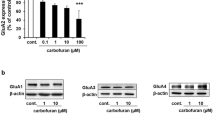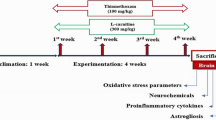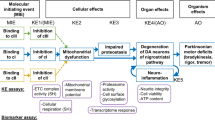Abstract
Carbamates belonged to an older insecticide group, with propoxur being representative of this group. However, today carbamates with hormonal effects on insects, like fenoxycarb, or with fungicide properties, like propamocarb, are also used. The goal was a comparison of three structurally and functional different carbamates with a possibly common toxicological mechanism. Primary neuronal cell cultures of the rat are a well established model to identify neurotoxic compounds like n-hexane or acrylamide. In this cell culture model endpoints such as viability, energy supply, glucose consumption, glutathione (GSH) levels and cytoskeleton elements were determined. Added to cultured rat cortical neurons for 1 week, fenoxycarb, propamocarb and propoxur considerably decreased ATP levels, mitochondrial membrane potential and glucose consumption. Besides this, fenoxycarb and propamocarb had an impact on neurofilaments. After recovery for 1 week, propoxur also showed effects on neurofilaments, whereas with the other carbamates no tendency for a recovery was seen. These effects were prevented completely by pyruvate for propoxur and propamocarb, and partly so for fenoxycarb. In contrast to the main experimental design, GSH was determined after 1-h treatment with the test substances. Surprisingly, the compounds had only slight or no effect on the GSH level within this time. Further mechanistic studies indicated that carbamates primarily interacted with SH-groups, most likely by interfering with glycolysis and the construction of fibrillary proteins like neurofilaments. The prevention by pyruvate and acetylcysteine pointed to these biochemical endpoints.



Similar content being viewed by others
References
Abou-Donia MB, Gupta RP (1994) Involvement of cytoskeletal proteins in chemically induced neuropathies. In: Chang LW (ed.) Principles in Neurotoxicology. Marcel Dekker, New York, pp 153–210
Agawal AK, Sankaranarayanan A, Sharma PL (1990) Effects of subacute insecticide exposure on body weight, drug response and electric convulsion in mice. Indian J Med Res 92:476–479
Alvares AP (1989) Pharmacology and toxicology of carbamates. In: Ballentyne B, Marrs TC (eds) Clinical and experimental toxicology of organophosphates and carbamates. Butterworth and Heinemann, Oxford, pp 40–46
Babu GRV, Reddy GR, Reddy ATV, Rajendra W, Chetty CS (1990) Modulations of ionic composition and ATPase system in the brain of albino rat under induced propoxur toxicity. Biochem Int 21:1105–1111
Bossi SR, Simpson JR, Isacson O (1993) Age dependence of striatal neuronal death caused by mitochondrial dysfunction. Clin Neurosci Neuropathol 4:73–76
Burden RS, Carter GA, Jones CS, Clark T, Holloway PJ (1988) Selective effects of propamocarb and prothiocarb on the fatty acid composition of some Oomycetes. In: Proceedings of Brighton Crop Protection Conference—Pests and Diseases 1988. British Crop Protection Council, pp 403-408
Cavanagh JB (1984) The problems of neurons with long axons. Lancet i:1284–1287
Dickoff DJ, Gerber O, Turovsky Z (1987) Delayed neurotoxicity after ingestion of carbamate pesticide. Neurology 37:1229–1231
Holbrook GL, Armstrong E, Bachmann JAS, Deasy BM, Schal C (2000) Role of feeding in the reproductive ‘group effect’ in females of the German cockroach, Blattella germanica. J Insect Physiol 46:941–949
Langcake P, Kuhn PJ, Wade M (1983) The mode of action of systemic fungicides. In: Hudson DH, Roberts TR (eds) Progress in Pesticide Biochemistry and Toxicology, vol 3. John Wiley, New York, pp 1–109
Liang D, Schal C (1994) Neural and hormonal regulation of calling behavior in Blattella germanica females. J Insect Physiol 40:251–258
Lin TM, Lee HJ (1998) Parallel control mechanisms underlying locomotor activity and sexual receptivity of the female German cockroach, Blattella germanica. J Insect Physiol 44:1039–1051
Lopachin RM, Lehning EJ (1997) The relevance of axonal swellings and atrophy to γ-dicetone neurotoxicity: a forum position paper. Neurotoxicology 18:7–22
Miller DB (1982) Neurotoxicity of pesticidal carbamates. Neurobehav Toxicol Teratol 4:779–787
Mundy WR, Freudenrich TM, Kodavanti PRS (1997) Aluminium potentiates glutamate-induced calcium accumulation and iron-induced oxygen free radical formation in primary neuronal cultures. Mol Chem Neuropathol 32:41–57
Papavizas GC, O’Neill NR, Lewis JA (1978) Fungistatic activity of propyl-N-(γ-dimethylaminopropyl)carbamate on Pythium spp. and its reversal sterols. Phytopathology 68:1667–1671
Röhrdanz E, Schmuck G, Ohler S, Tran-Thi Q-H, Kahl R (2001) Changes in antioxidant enzyme expression on response to hydrogen peroxide in rat astroglia cells. Arch Toxicol 3:150–158
Sabri MI (1994) Attenuation of glyceraldehyde-3-phosphate dehydrogenase activity and ATP level in rat brain synaptosomes by acrylamide. Neurochem Res 19:1439–1444
Sabri MI, Moore CL, Spencer PS (1979a) Studies on the biochemical basis of distal axonopathies. I. Inhibition of gylcolysis by neurotoxic hexacarbon compounds. J Neurochem 32:683–689
Sabri MI, Ederle K, Holdsworth CE, Spencer PS (1979b) Studies on the biochemical basis of distal axonopathies. II. Specific inhibition of fructose-6-phosphate kinase by 2,5-hexandione and methyl-butyl ketone. Neurotoxicology 1:285–297
Schmuck G, Schlüter G (1996) An in vitro method for toxicological investigations of environmental neurotoxins in primary neuronal cell cultures. Toxicol Ind health 12:683–696
Schmuck G, Ahr HJ, Schlüter G (2000) Rat cortical neuron cultures: An in vitro model for differentiating mechanisms of chemically induced neurotoxicity. In Vitro Mol Toxicol 13:37–50
Schmuck G, Röhrdanz E, Tran-Thi Q-H, Kahl R, Schluter G (2002a) Oxidative stress in primary brain cells induced by paraquat in vitro. Neurotox Res 4:1–13
Schmuck G, Ahr H-J, Mihail F, Stahl B, Kayser M (2002b) Effects of the dithiocarbamate fungicide propineb in primary neuronal cell cultures and skeletal muscle cells of the rat. Arch Toxicol 76:414–422
Author information
Authors and Affiliations
Corresponding author
Rights and permissions
About this article
Cite this article
Schmuck, G., Mihail, F. Effects of the carbamates fenoxycarb, propamocarb and propoxur on energy supply, glucose utilization and SH-groups in neurons. Arch Toxicol 78, 330–337 (2004). https://doi.org/10.1007/s00204-004-0546-3
Received:
Accepted:
Published:
Issue Date:
DOI: https://doi.org/10.1007/s00204-004-0546-3




